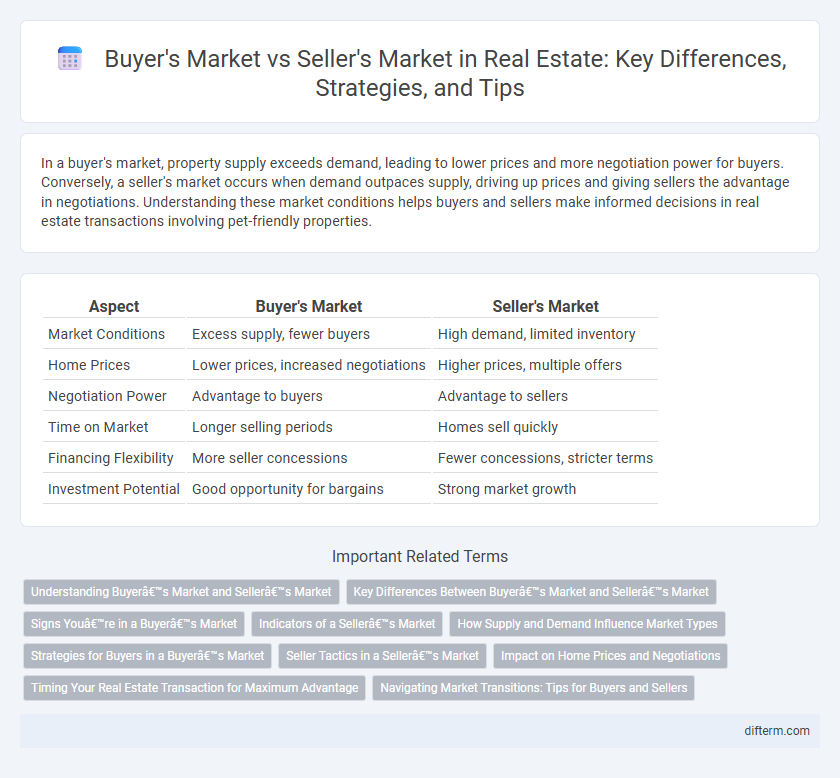In a buyer's market, property supply exceeds demand, leading to lower prices and more negotiation power for buyers. Conversely, a seller's market occurs when demand outpaces supply, driving up prices and giving sellers the advantage in negotiations. Understanding these market conditions helps buyers and sellers make informed decisions in real estate transactions involving pet-friendly properties.
Table of Comparison
| Aspect | Buyer's Market | Seller's Market |
|---|---|---|
| Market Conditions | Excess supply, fewer buyers | High demand, limited inventory |
| Home Prices | Lower prices, increased negotiations | Higher prices, multiple offers |
| Negotiation Power | Advantage to buyers | Advantage to sellers |
| Time on Market | Longer selling periods | Homes sell quickly |
| Financing Flexibility | More seller concessions | Fewer concessions, stricter terms |
| Investment Potential | Good opportunity for bargains | Strong market growth |
Understanding Buyer’s Market and Seller’s Market
A buyer's market occurs when housing supply exceeds demand, giving buyers leverage to negotiate lower prices and better terms. In contrast, a seller's market emerges when demand outpaces supply, enabling sellers to command higher prices and accept favorable offers quickly. Recognizing these market conditions helps buyers and sellers strategize effectively, optimizing their real estate transactions.
Key Differences Between Buyer’s Market and Seller’s Market
In a buyer's market, housing inventory exceeds demand, leading to lower prices and more negotiation power for buyers, while in a seller's market, limited inventory and high demand drive up prices and favor sellers. Key differences include market supply, price trends, and buyer versus seller leverage during transaction negotiations. Understanding these factors helps real estate professionals and investors make strategic decisions regarding timing and pricing in property transactions.
Signs You’re in a Buyer’s Market
In a buyer's market, homes typically stay listed longer with prices often reduced below initial asking value, signaling increased inventory and decreased demand. Mortgage rates may also be more favorable, encouraging negotiation leverage for buyers. Indicators such as multiple price cuts, increased days on market, and a higher ratio of active listings to sales highlight a buyer's market environment.
Indicators of a Seller’s Market
High demand for properties combined with low housing inventory typically signals a seller's market, resulting in quicker sales and rising home prices. Key indicators include reduced days on market, multiple offer situations, and bidding wars that drive up final sale prices. Elevated mortgage applications and increased homebuyer competition further confirm a strong seller's market environment.
How Supply and Demand Influence Market Types
Supply and demand dynamics critically shape real estate markets, with a buyer's market emerging when housing inventory exceeds demand, leading to lower prices and greater negotiation power for buyers. Conversely, a seller's market occurs when demand outpaces supply, driving up prices and reducing availability, which favors sellers. Understanding these fluctuations helps investors and homebuyers strategize effectively based on current market conditions.
Strategies for Buyers in a Buyer’s Market
Buyers in a buyer's market benefit from lower prices and increased inventory, allowing for more negotiation leverage and favorable contract terms. Effective strategies include conducting thorough market research to identify undervalued properties, securing mortgage pre-approval to strengthen offers, and leveraging contingencies to protect investment. Patience and careful timing can further maximize value, as motivated sellers are more likely to accept lower bids or offer incentives.
Seller Tactics in a Seller’s Market
In a seller's market, employing strategic pricing tactics is crucial to maximize property value, as high demand and low inventory give sellers the upper hand. Creating urgency through limited-time offers and leveraging multiple bids can drive competitive pricing and faster sales closures. Highlighting unique property features and staging effectively can further differentiate listings, attracting serious buyers willing to pay a premium.
Impact on Home Prices and Negotiations
In a buyer's market, increased inventory and reduced demand typically drive home prices down, giving buyers leverage to negotiate lower prices and request concessions. Conversely, a seller's market features limited inventory and high demand, often resulting in rising prices and less room for negotiation, benefiting sellers with competitive offers. Understanding these market dynamics is crucial for effective pricing strategies and negotiation tactics in real estate transactions.
Timing Your Real Estate Transaction for Maximum Advantage
Timing your real estate transaction can significantly impact financial outcomes, as a buyer's market offers lower prices and greater negotiation power due to excess inventory and high buyer demand. In contrast, a seller's market features limited housing supply and elevated prices, favoring sellers seeking quick sales at premium offers. Monitoring market indicators such as inventory levels, mortgage rates, and local economic trends allows buyers and sellers to strategically time their transactions for optimal advantage.
Navigating Market Transitions: Tips for Buyers and Sellers
Understanding current indicators such as inventory levels, average days on market, and price trends is essential for navigating transitions between buyer's and seller's markets effectively. Buyers should leverage negotiation opportunities and financing options during a buyer's market, while sellers benefit from pricing strategies and marketing techniques that highlight property strengths in a seller's market. Staying informed about local market shifts and consulting with real estate professionals can optimize decision-making and timing for successful transactions.
buyer’s market vs seller’s market Infographic

 difterm.com
difterm.com